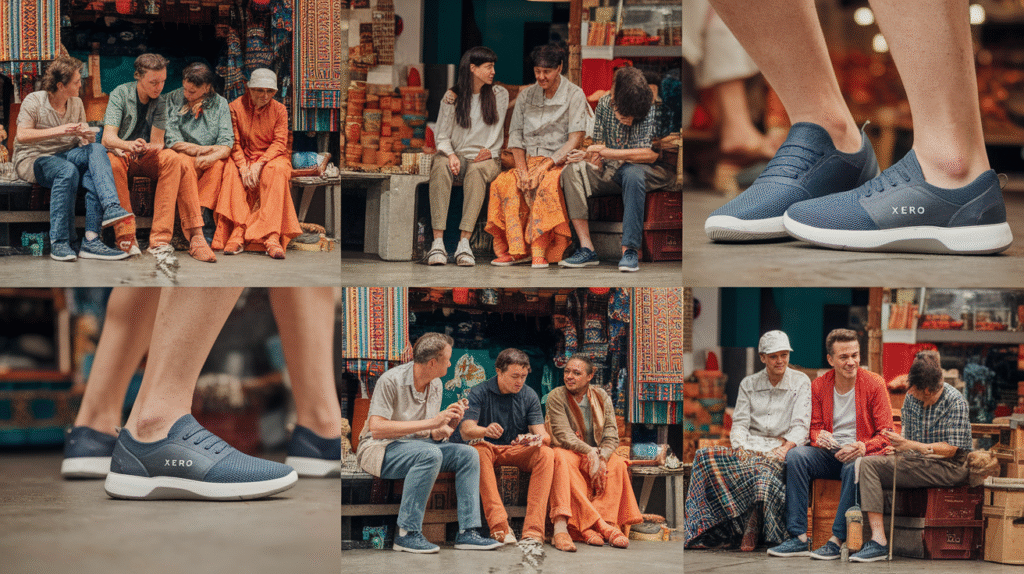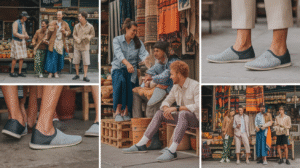
Anthropology offers fascinating insights into the world of barefoot footwear, tracing its journey from the rich traditions of Aboriginal cultures to contemporary urban settings. As you explore this captivating evolution, you’ll discover how cultural practices and beliefs surrounding minimalist footwear shape your understanding of comfort, connection to the earth, and personal expression. Unpacking these themes not only enriches your knowledge but also challenges your perceptions of how what you wear on your feet can reflect deeper cultural significance.
Bridging the Past and Present in Footwear
Today’s footwear landscape beautifully intertwines ancient practices with contemporary design, cultivating a growing appreciation for barefoot footwear. This evolution not only honors traditional indigenous methods but also adapts them to your modern lifestyle. By recognizing the significance of historical footsteps, you’ll find a fusion of cultural respect and functional aesthetics in your everyday shoes.
Indigenous Foot Conditioning Practices vs. Modern Adaptation
Indigenous communities around the world traditionally employed specific conditioning techniques for their feet to adapt to varying terrains. Practices such as walking barefoot over different surfaces strengthened the arches and muscles in ways that many modern adaptations often overlook. Nowadays, you might find minimalist shoes that mimic these effects, yet they seldom replicate the authentic experience of direct contact with the earth.
Military Applications: From Roman Caligae to Modern Tactical Designs
The evolution of military footwear showcases significant adaptation, from the robust Roman caligae, designed for durability and traction, to contemporary tactical boots that blend protection with agility. As you examine these transitions, the underlying principle remains clear: functionality is paramount in hostile environments, necessitating gear that supports endurance and mobility.
Roman caligae were a sophisticated solution for soldiers, consisting of sturdy leather with open-toe design for breathability. This ancient footwear featured thick soles that absorbed shock and provided traction, vital for combat scenarios. Fast forward to today, and tactical boots utilize advanced materials like Kevlar and waterproof membranes to enhance durability. Modern designs integrate padded collars and advanced cushioning systems to prevent injuries during intense military maneuvers. As you consider the heritage behind military footwear, it’s evident that these styles lay the groundwork for today’s innovations, marrying heritage, practicality, and cutting-edge technology to meet the needs of present-day warriors.
The Urban-Rural Footwear Divide
The disparity in footwear choices between urban and rural settings reflects deeper cultural and practical differences. Urban environments often dictate a premium on style and branding, while rural areas may prioritize functionality and durability. As barefoot footwear gains traction, urban dwellers tend to embrace its minimalist design for both a fashionable statement and perceived health benefits. Conversely, those in rural areas might remain hesitant due to traditional norms or the practical demands of their surroundings.
Urban Adoption Rates: Trends and Influences
In urban centers, a noticeable shift toward barefoot footwear is emerging, with adoption rates climbing steadily over the past decade. Factors driving this trend include the rise of health consciousness, a growing interest in natural movement, and the influence of fitness trends such as yoga and running. Surveys indicate that about 35% of city dwellers have sought out barefoot-style shoes, reflecting a cultural embrace of different body mechanics.
Gender Differences in Adoption Barriers: Who’s Stepping Forward?
Gender plays a significant role in the acceptance of barefoot footwear, with differing motivations influencing men’s and women’s choices. Women often face heightened societal pressures regarding fashion and aesthetics, potentially preventing them from stepping into minimalist styles. On the other hand, men might be more encouraged by performance and health benefits, leading to higher adoption rates among male populations.
Further exploration into the gendered dimensions surrounding barefoot footwear reveals that societal expectations heavily influence women’s adoption rates. Women frequently navigate a landscape where the ideals of beauty and fashion can overshadow practical health benefits. For instance, research indicates that generally, 45% of men in urban areas are open to barefoot shoes, compared to just 30% of women. Female consumers often grapple with the tension between form and function, making them cautious as they weigh the aesthetics of barefoot footwear against their desire for comfort and support. Empowering women through awareness campaigns and showcasing stylish barefoot options could enhance their willingness to embrace this trend. The result could reshape urban footwear narratives and create an inclusive space for all genders.

Future Innovations in Barefoot Footwear
As the demand for barefoot footwear continues to evolve, innovative technologies are set to reshape the way you approach comfort and performance in your shoes. Advancements in materials science and custom fitting will not only enhance functionality but also personalize your walking experience, merging traditional wisdom with cutting-edge design. You are about to witness an era where your footwear is as unique as the journey it accompanies.
The Rise of 3D Scanning Customization: Tailoring Comfort
3D scanning technology is making significant strides in the customization of barefoot footwear, allowing for a precise fit that molds to your unique foot shape. This means that instead of settling for standard sizes, your shoes can be designed to align perfectly with the contours of your feet, improving comfort and reducing the risk of injury. Custom-fit options will not only enhance your walking experience but will also make barefoot shoes more accessible for a diverse range of feet.
Smart Sensor Integration: How Technology Will Transform Footwear
Smart sensor integration is poised to revolutionize the footprint of barefoot footwear by embedding tech directly into the soles. These smart features can track everything from distance covered to foot pressure, providing valuable insights to help you optimize your walking habits. With data-driven feedback at your fingertips, you can adjust your activities in real-time for ultimate performance and safety.
Imagine having real-time analytics at your disposal while you walk or run. Smart sensors can monitor your gait, providing alerts if any abnormalities arise that may lead to injury. Some innovative brands are already exploring footwear that can analyze your foot’s impact on varied terrains, suggesting personalized adjustments for style or cushioning on the go. This integration bridges the gap between smart technology and traditional barefoot philosophy, ensuring that you maintain a natural stride while benefiting from the latest in wearable tech. The potential for improvement in sports performance, rehabilitation, and daily comfort is boundless, redefining how you interact with your environment through every step.

Final Words
To wrap up, your journey through the cultural anthropology of barefoot footwear reveals a rich tapestry woven from Aboriginal traditions to contemporary urban practices. By embracing the principles of natural movement and connection to the earth, you gain insights into how this footwear philosophy transcends mere fashion, influencing lifestyle and community values. As you explore these diverse perspectives, consider how your choices in footwear can reflect and support a deeper understanding of cultural roots and modern adaptability.







It’s fascinating how the journey of barefoot footwear encapsulates not just personal comfort but also a rich tapestry of cultural history. Having recently embraced minimalist shoes myself, I’ve found that they make me feel more connected to my surroundings, almost as if I’m experiencing the ground in a way that conventional shoes never allowed.
What a compelling exploration of the cultural journey of barefoot footwear! Your insights into how these practices intertwine with both ancient traditions and modern lifestyles truly resonate with me. As someone who has always felt a strong connection to the earth through my own lifestyle choices, I appreciate the way you’ve shed light on how our footwear can reflect our personal identities and cultural histories.
Isn’t it wild how something as simple as footwear can carry the weight of history on its soles? I mean, here we are, navigating bustling city streets in what used to be the embodiment of cultural heritage! Growing up, my idea of comfort was a pair of fuzzy slippers—who knew bare feet could actually connect us to our ancestors?
It’s intriguing to see how barefoot footwear serves as a bridge between ancient traditions and modern lifestyle, particularly in our increasingly mechanized and comfort-driven world. Your exploration of this subject makes me reflect on the broader implications of how our choices in footwear are not just about fashion, but also about health and cultural identity.
Your exploration of barefoot footwear really highlights the broader theme of how our clothing and accessories serve as cultural artifacts. It’s intriguing to consider how the minimalist design of barefoot footwear not only caters to our physical comfort but also connects us to deeper cultural narratives. For instance, the practice of going barefoot or wearing minimal shoes in various indigenous cultures often symbolizes a profound connection to the land and an appreciation for natural movement.
Your exploration of the relationship between anthropology and barefoot footwear is both thought-provoking and timely. As someone who has recently adopted more minimalist shoes, I can personally attest to how they shift one’s perception of movement and connection to the environment. It’s fascinating to consider how much our footwear can be a reflection of our cultural narratives and personal identities.
Your exploration of barefoot footwear through an anthropological lens resonates deeply with me, particularly as someone who has spent time in various cultures where minimalism in footwear is celebrated. It’s intriguing to see how these practices not only reflect cultural beliefs but also promote a deeper connection to the earth and our surroundings.
It’s truly fascinating to delve into the relationship between footwear and cultural identity, particularly through the lens of anthropology. The journey you’ve detailed from traditional Aboriginal practices to the modern embrace of barefoot footwear resonates deeply with me. It serves as a poignant reminder of how our choices in clothing, even down to our shoes, can echo centuries of cultural history and personal significance.
Your exploration of the relationship between anthropology and barefoot footwear truly resonates with me and sparks a cascade of thoughts around the significance of our choices in footwear being deeply rooted in culture. I’m fascinated by how barefoot footwear not only serves as a functional necessity but also acts as a bridge between history and our current lifestyle. It’s incredible to think about how what we wear on our feet can echo the stories of indigenous cultures, reflecting their beliefs and their connection to the earth.
It’s refreshing to hear your perspective on the interplay between footwear choices and culture. Our footwear indeed tells a complex story that goes far beyond mere functionality. It’s remarkable to consider how barefoot footwear, often minimalist and unassuming, connects us to deep-rooted traditions and experiences that span generations and continents.
The intersection of anthropology and footwear is indeed a fascinating lens through which to examine cultural evolution. I have found that the minimalist movement, often attributed to health trends advocating for natural movement, also serves as a conduit for deeper cultural appreciation. For instance, brands inspired by indigenous designs not only promote comfort but also prompt us to consider the stories and histories woven into these traditions.
I thoroughly enjoyed your exploration of the journey of barefoot footwear through anthropology! It’s truly fascinating to see how the threads of culture intertwine with our everyday choices in footwear. I’ve often found myself reflecting on my own experiences with minimalist footwear and how they resonate with the sentiments you outlined so beautifully.
I’m glad you found the exploration of barefoot footwear compelling—it’s such a rich topic. I often wonder how footwear choices can reflect broader values we carry, especially in our fast-paced, technology-driven lives. It seems like minimalist footwear, in particular, encourages us to reconnect with our bodies and the environment in a much more primal way.
Glad you enjoyed the deep dive into barefoot footwear and its surprising links to culture! It’s wild how something as simple as shoes can reflect so much about our lifestyles and values.
It’s fascinating to consider how footwear not only serves a practical function but also carries a wealth of cultural meaning. The way you illustrated the evolution from Aboriginal traditions to contemporary urban styles truly resonates with me. It makes me reflect on my own choices in footwear and how they relate to comfort and my connection to the environment.
Your exploration of barefoot footwear as a cultural phenomenon is truly enlightening. I find it intriguing how our shoes – or lack thereof – can act as a bridge between tradition and modernity. Growing up, I had the opportunity to visit some Indigenous communities, where I witnessed firsthand the deep respect for the earth that is woven into their practices. This connection to the ground, expressed through simple, minimalist footwear, resonates with so many of us who live in urban settings yet long for that same connection.
Your exploration of barefoot footwear and its anthropological roots raises some intriguing questions about the intersection of culture and modernity. It’s fascinating to consider how these ancient practices not only represent a connection to the earth but also reflect evolving notions of comfort and identity in our fast-paced world. Personally, I’ve found that as we navigate urban settings, there is often a disconnect from our environment that traditional barefoot practices aim to bridge.
It’s interesting how the journey of barefoot footwear mirrors broader cultural shifts. I’ve been experimenting with minimalist shoes for a while now, and it’s made me rethink my connection to the ground—like how we often rush through life without fully experiencing it beneath our feet. I even found inspiration in the way traditional Aboriginal practices emphasize not just comfort, but a deep connection to nature.
I find it truly fascinating how the journey of barefoot footwear connects us to a diverse tapestry of cultures and philosophies. The way you’ve highlighted the interplay between ancient practices and modern design really resonates with me. It’s intriguing to think about how minimalist footwear does more than just provide comfort; it can also serve as a bridge to our past, reminding us of the deep-rooted traditions of Aboriginal cultures.
Reading through your insights on the intersection of anthropology and barefoot footwear truly resonates with me. It’s remarkable how the journey of minimalist footwear reflects not just a practical choice but also a profound connection to culture and identity. The acknowledgment of Aboriginal traditions and their significance in contemporary contexts highlights how our choices—in this case, what we wear on our feet—can echo the narratives of those who came before us.
Your exploration of the intersection between anthropology and barefoot footwear is truly thought-provoking. The journey of footwear from the traditional practices of Aboriginal cultures to modern interpretations highlights not only the importance of cultural heritage but also the evolving relationship humans have with their environment.
Your exploration of the connection between barefoot footwear and cultural practices really resonates with me. It’s fascinating how something as seemingly simple as our choice of shoes can embody such deep cultural significance. In my own experience, transitioning to minimalist footwear has not only changed my physical comfort but also helped me feel more grounded and connected to nature.
Your exploration of barefoot footwear through an anthropological lens resonates deeply with me. I’ve often found that the most meaningful connections we can make with our surroundings stem from the ground up—quite literally in this case. The concept of comfort as it relates to one’s cultural background is fascinating, particularly how indigenous practices have shaped not only how we wear footwear but also our relationship with the earth.
It’s so interesting to think about how our footwear choices can reflect deeper cultural values and traditions. I remember when I first started to explore barefoot running — the idea of reconnecting with the ground was both liberating and a little daunting. It makes me appreciate how cultures that have worn minimalist footwear for centuries didn’t just see it as a practical choice but as a way to stay grounded in their environment.